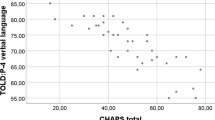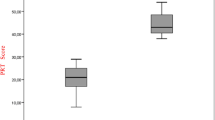Abstract
Purpose
This study aimed to assess the written language skills of children with auditory brainstem implants (ABI).
Methods
In this study, 15 children (from second to eighth grades) with ABI were evaluated for their written language abilities using a written expression skill assessment form. Five different features of written expression points were scored and analyzed, yielding a composite score for written expression skills.
Results
This study showed that all children with ABI needed more verbal cues than spontaneously written samples. Moreover, these children used short and simple sentences with limited vocabulary and repeated words and sentences. Furthermore, these children were deficient in writing an introduction, the body, and the conclusion paragraphs and could not write events in a logical sequence.
Conclusions
The written language skills of children with ABI depend on age at implantation, duration of implant use, and additional handicaps. Written expression skills in children with ABI are highly complex skills. The findings highlight the importance of ABI during the critical language development period and the enhancement of training programs for written language skills in children who underwent ABI.

Similar content being viewed by others
References
Noij KS, Kozin ED, Sethi R, Shah PV, Kaplan AB, Herrmann B et al (2015) Systematic review of nontumor pediatric auditory brainstem implant outcomes. Otolaryngol Head Neck Surg 153(5):739–750. https://doi.org/10.1177/0194599815596929
Shannon RV (2015) Auditory implant research at the house ear institute 1989–2013. Hear Res 322:57–66. https://doi.org/10.1016/j.heares.2014.11.003
Birman CS, Powell HR, Gibson WP, Elliott EJ (2016) Cochlear implant outcomes in cochlea nerve aplasia and hypoplasia. Otol Neurotol 37(5):438–445. https://doi.org/10.1097/MAO.0000000000000997
Shannon R, Colletti L, Colletti V (2016) The neuroscience of the pediatric auditory brainstem implant. Ped cochlear implantation. Springer, New York, NY, pp 237–245
Yousef M, Mesallam TA, Almasaad A, Alhabib S, Hagr A, Alzhrani F (2021) Cochlear implantation versus auditory brainstem implantation in children with auditory nerve deficiencies. Eur Arc Oto Rhino Laryngol. https://doi.org/10.1007/s00405-021-06792-8
Aaron KA, Kari E, Friedman RA, Niparko JK (2016) Cochlear implants and auditory brainstem implants for children: surgical considerations. In: Eisenberg LS (ed) Clinical management of children with cochlear implants, 2nd edn. Plural Publishing, San Diego, CA, pp 69–103
Wilkinson EP, Eisenberg LS, Krieger MD, Schwartz MS, Winter M, Glater JL et al (2017) Initial results of a safety and feasibility study of auditory brainstem implantation in congenitally deaf children. Otology Neurotol: Off Publ Am Otol Soc, Am Neurotol Soc Eur Acad Otol Neurotol 38(2):212. https://doi.org/10.1097/MAO.0000000000001287
Goffi-Gomez MVS, Magalhães AT, Neto RB, Tsuji RK, Gomes MDQT, Bento RF (2012) Auditory brainstem implant outcomes and MAP parameters: report of experiences in adults and children. Int J Ped Otorhinolaryngol 76(2):257–264. https://doi.org/10.1016/j.ijporl.2011.11.016
Colletti L, Shannon RV, Colletti V (2014) The development of auditory perception in children after auditory brainstem implantation. Audiol Neurotol 19(6):386–394. https://doi.org/10.1159/000363684
Fernandes NF, Gomes MDQT, Tsuji RK, Bento RF, Goffi-Gomez MVS (2020) Auditory and language skills in children with auditory brainstem implants. Int J Ped Otorhinolaryngol 132:110010. https://doi.org/10.1016/j.ijporl.2020.110010
Friederici AD (2006) The neural basis of language development and its impairment. Neuron 52(6):941–952. https://doi.org/10.1016/j.neuron.2006.12.002
Hess M, Wheldall K (1999) Strategies for improving the written expression of primary children with poor writing skills: A sociocognitive perspective. Aust J Learn Diffic 4(4):14–20. https://doi.org/10.1080/19404159909546605
Graham S, Perin D (2007) A meta-analysis of writing instruction for adolescent students. J Educ Psychol 99(3):445. https://doi.org/10.1037/0022-0663.99.3.445
Romig JE, Therrien WJ, Lloyd JW (2017) Meta-analysis of criterion validity for curriculum-based measurement in written language. J Spec Educ 51(2):72–82. https://doi.org/10.1177/0022466916670637
Thomas LJ, Gerde HK, Piasta SB, Logan JA, Bailet LL, Zettler-Greeley CM (2020) The early writing skills of children identified as at-risk for literacy difficulties. Ear Child Res Q 51:392–402. https://doi.org/10.1016/j.ecresq.2020.01.003
Herder A, Berenst J, de Glopper K, Koole T (2018) Reflective practices in collaborative writing of primary school students. Int J Educ Res 90:160–174. https://doi.org/10.1016/j.ijer.2018.06.004
Werfel KL (2017) Emergent literacy skills in preschool children with hearing loss who use spoken language: initial findings from the early language and literacy acquisition (ELLA) study. Lang Speech Hear Ser 48(4):249–259. https://doi.org/10.1044/2017_LSHSS-17-0023
Oliveira KLSD, Feitosa ALF, Depolli GT, Pedruzzi CM (2020) Reading and writing performance in cochlear implant users: integrative review. Audiolog Comm Res. https://doi.org/10.1590/2317-6431-2020-2298
Sugaya A, Fukushima K, Takao S, Kasai N, Maeda Y, Fujiyoshi A et al (2019) Impact of reading and writing skills on academic achievement among school-aged hearing-impaired children. Int J Ped Otorhinolaryngol 126:109619. https://doi.org/10.1016/j.ijporl.2019.109619
Smolen ER, Hartman MC, Wang Y (2020) Reading achievement in children with hearing loss who use listening and spoken language: results and implications from a 2-year study. Perspect ASHA Spec Interest Groups 5(6):1380–1387. https://doi.org/10.1044/2020_PERSP-20-10006
Karasu HP, Girgin U (2007) Assessment of writing skills of hearing impaired students who attend mainstream classes. Anadolu Univ J Soc Sci 7(1):467–488
Archbold S, Lutman ME, Marshall DH (1995) Categories of auditory performance. Ann Otol Rhinol Laryngol Suppl 166:312–314
Cox RM, McDaniel DM (1989) Development of the speech Intelligibility Rating (SIR) test for hearing aid comparisons. J Speech Lang Hear Res 32(2):347–352
Guven S, Topbas S (2014) Adaptation of the test of early language development-(TELD-3) into Turkish: reliability and validity study. Int J Ear Child Spec Educ 6(2):151–176
Harris M, Terlektsi E (2011) Reading and spelling abilities of deaf adolescents with cochlear implants and hearing aids. J Deaf Stud Deaf Educ 16(1):24–34. https://doi.org/10.1093/deafed/enq031
Dammeyer J (2014) Literacy skills among deaf and hard of hearing students and students with cochlear implants in bilingual/bicultural education. Deaf Educ Int 16(2):108–119. https://doi.org/10.1179/1557069X13Y.0000000030
Johnson C, Goswami U (2010) Phonological awareness, vocabulary, and reading in deaf children with cochlear implants. J Speech Lang Hear Res 53:237–261. https://doi.org/10.1044/1092-4388(2009/08-0139)
Geers AE, Hayes H (2011) Reading, writing, and phonological processing skills of adolescents with 10 or more years of cochlear implant experience. Ear Hear 32:49S-59S. https://doi.org/10.1097/AUD.0b013e3181fa41fa
Mayer C, Watson L, Archbold S, Ng ZY, Mulla I (2016) Reading and writing skills of deaf pupils with cochlear implants. Deaf Educ Int 18(2):71–86. https://doi.org/10.1080/14643154.2016.1155346
Spencer LJ, Barker BA, Tomblin JB (2003) Exploring the language and literacy outcomes of pediatric cochlear implant users. Ear Hear 24(3):236. https://doi.org/10.1097/01.AUD.0000069231.72244.94
Karasu HP (2017) Writing skills of hearing-impaired students who benefit from support services at public schools in Turkey. World J Ed 7(4):104–116. https://doi.org/10.5430/wje.v7n4p104
Aslan F, Ozkan HB, Yücel E, Sennaroglu G, Bilginer B, Sennaroglu L (2020) Effects of age at auditory brainstem implantation: impact on auditory perception, language development, speech Intelligibility. Otol Neurotol 41(1):11–20. https://doi.org/10.1097/MAO.0000000000002455
Celik ME (2012) An evaluation of the eighth grade students writing skills on various different variables. Turkluk Bilimi Arastirmalari XXXII:13–21
Yasamsal A, Yucel E, Sennaroglu G (2013) Relationship between age of cochlear implantation with written language skills in children. J Int Adv Otol 9(1):38–45
Easterbrooks SR, Stoner M (2006) Using a visual tool to increase adjectives in the written language of students who are deaf or hard of hearing. Comm Disord Q 27(2):95–109. https://doi.org/10.1177/15257401060270020701
Seidman LJ, Biederman J, Monuteaux MC, Doyle AE, Faraone SV (2001) Learning disabilities and executive dysfunction in boys with attention-deficit/hyperactivity disorder. Neuropsychol 15(4):544. https://doi.org/10.1037/0894-4105.15.4.544
Re AM, Pedron M, Cornoldi C (2007) Expressive writing difficulties in children described as exhibiting ADHD symptoms. J Learn Dis 40(3):244–255. https://doi.org/10.1177/00222194070400030501
Re AM, Caeran M, Cornoldi C (2008) Improving expressive writing skills of children rated for ADHD symptoms. J Learn Dis 41(6):535–544
Acknowledgements
There are no funding sources to declare. The authors thank the participants and their families for their involvement in this study. The authors report no conflicts of interest. The authors alone are responsible for the content and writing of the paper.
Funding
The authors did not receive support from any organization for the submitted work.
Author information
Authors and Affiliations
Contributions
All the authors contributed to the study conception, analysis and design. Material preparation, data collection and analysis were performed by HBO, FA and EY. The first draft of the manuscript was written by HBO, FA, EY, GS and LS. All the authors read and approved the final manuscript.
Corresponding author
Ethics declarations
Conflict of interest
The authors declare that they have no conflict of interest.
Ethical approval
All the procedures performed in studies involving human participants were in accordance with the ethical standards of the institutional and/or national research committee and with the 1964 Helsinki Declaration and its later amendments or comparable ethical standards. Our current study was presented as a preliminary study at the 15th International Conference on Cochlear Implants and other Implantable Auditory Technologies, 27–30 June 2018.
Consent to participate
This study was conducted at the Hacettepe University Department of Otorhinolaryngology and Audiology. Patients routinely signed a form consenting the use of personal data for scientific and research purposes before enrollment.
Additional information
Publisher's Note
Springer Nature remains neutral with regard to jurisdictional claims in published maps and institutional affiliations.
Rights and permissions
About this article
Cite this article
Ozkan, H.B., Aslan, F., Yucel, E. et al. Written language skills in children with auditory brainstem implants. Eur Arch Otorhinolaryngol 279, 3937–3945 (2022). https://doi.org/10.1007/s00405-022-07359-x
Received:
Accepted:
Published:
Issue Date:
DOI: https://doi.org/10.1007/s00405-022-07359-x




